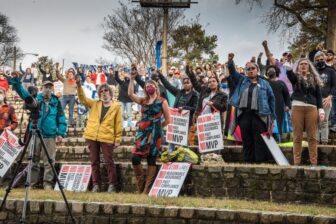This coming week, in New York City and Pittsburgh, there will be important United Nations and G20 meetings that could advance the process of coming up with a new international treaty to address the climate crisis. This coming week will also see the opening salvo of “civil society” groups in the streets taking action to press their demands for not just any treaty but one that is strong and fair, one that reflects the deepening of the crisis.
From December 7-18, in Copenhagen, Denmark, 190 or so nations will come together in for the annual U.N. Climate Conference, but this one is particularly important. One reason is that it will be the first one in eight years where the U.S. delegation will be led by people who believe that climate change is real, serious and that action is needed to address it. But much more significant is that this is the U.N. conference that was planned, two years ago at a UN climate conference in Bali, Indonesia, as the place and the time that the world had to come up with a much stronger international climate treaty than the Kyoto Protocol.
The Kyoto Protocol became operative on February 16, 2005, and as of sometime in 2012 it will no longer be in effect. The countries which signed it and agreed to reduce their emissions by an average of 5% below 1990 levels have until then to do so. At that point, if there is no international treaty that has been negotiated, ratified by enough countries and gone into effect, there will be nothing that replaces the expired Kyoto treaty.
Since it is expected that it will take at least two years for enough countries to ratify a treaty, the Copenhagen conference has been seen as critical so that there’s no gap in between Kyoto and a new treaty. However, as we’re less than three months out from Copenhagen, with 15 actual negotiating days between now and the end of Copenhagen (including five days in Barcelona, Spain Nov. 2-6), and with a significant number of major issues unresolved and points of conflict, especially between the countries of the Global South (developing countries) and the Global North (developed), it is not looking hopeful for any kind of treaty, much less a good one, to be adopted and signed at Copenhagen.
In March, Yvo de Boer, executive secretary of the UN Framework Convention on Climate Change and primary treaty negotiator, outlined his main priorities short of a finalized treaty. The talks, he said, needed to deliver clarity on near-term (by 2020) emissions cuts for both industrialized countries and developing countries, while industrialized countries needed to devote significant resources to help poorer nations invest in clean-energy tech and adapt to climate change. De Boer said if those things happened, “we have a robust architecture for a resounding response to climate change at the international level.”
The Major Issues
Over the last several months, the issue of climate justice obligations has become contentious and major. At the G20 meeting in Pittsburgh next week this issue is supposed to be worked on; Obama proposed that this be a central issue for this meeting at an earlier G20 meeting in July.
There are various projections for how much money is needed. The lowest figure by objective sources (not developing countries shirking their obligations) seems to be around $100 billion/year. Oxfam, the International Climate Action Network (CAN), the Alliance of Small Island Nations and African countries are calling for $150-160 billion/year. But a United Nations report that came out on September 1 said that the developing nations need a $500-600 billion/year “Marshall Plan” to tackle climate change. The World Economic and Social Survey called for a “Global Sustainable New Deal” to overcome the “woefully inadequate” estimate of 21 billion dollars annually currently set aside internationally to adapt to and cope with climate change.
$500-600 billion is 1% of world GDP. It’s also less than what the U.S. spends each year on its military budget.
It is not a good sign that, about a week ago, the European Union announced that they would contribute no more than $15 billion/year of direct assistance. Their proposal included language suggesting the EU could use part of the future development aid it has already promised for poor countries as part of its climate change contribution. An Oxfam leader said the proposal would “rob tomorrow’s hospitals and schools in developing countries to pay for them to tackle climate change now.”
The other major issue, of course, is how much the countries of the Global North will reduce their emissions. Related to this, for some countries, is how much the developing countries are willing to commit to doing




